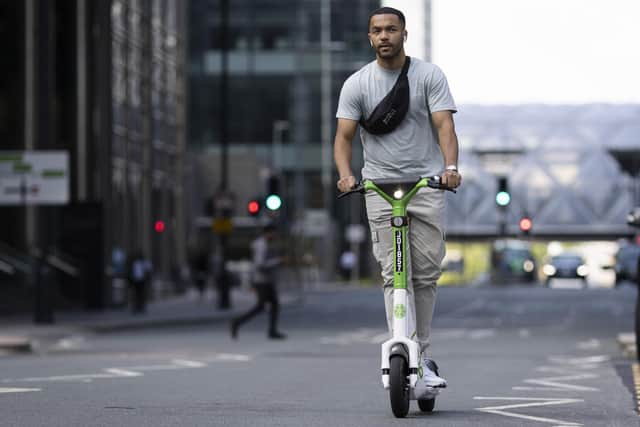Law needs to catch up with e-scooters - Thomas Mitchell
Together, they form part of a group of vehicles which the Government refers to as “powered transporters”. They are generally defined as a variety of novel and emerging personal transport devices powered by a motor, usually an electric one.
The most prominent of these powered transporters and the one you may have seen for yourself buzzing around our streets, is the electric scooter (e-scooter) – a scooter fitted with an electric motor for instant and eco-conscious propulsion.
Advertisement
Hide AdAdvertisement
Hide AdBroadly speaking, they are fitted with a board for standing on, two (or three) wheels, a brake (perhaps front and back), a set of handlebars, a throttle, a small battery and of course, the electric motor powering it all. These machines can propel users swiftly and almost silently up to 15mph (in some cases faster) and form the first of a new wave of personal transportation for thousands of people every day. E-scooters have the potential to be a valuable tool in the Active Travel armoury and help us meet Scotland’s net zero carbon emissions target.


But here’s the catch. Currently, in Scotland, it’s illegal to ride an e-scooter on a road, pavement, shared use path or any public place. The only place you can legally ride one is on private land, with the landowner’s permission.
E-scooters are a classic example of how technological change can outpace the legal framework that currently exists governing transportation. Under the current legislative framework, specifically the Road Traffic Act 1988, e-scooters and other new-fangled powered transporters, are considered to be motor vehicles.
A “motor vehicle” is defined in the Act as “any mechanically-propelled vehicle intended or adapted for use on roads”. What this means is that these powered transporters, if used on the road, require to be insured, taxed and meet a whole myriad of other requirements that a motor vehicle would have to meet such as licence plates, indicators and rear lights.
In reality, the majority of e-scooters currently on sale do not meet the legal requirements to be used on the road under our current legislative framework. The e-scooter market has exploded, with the global market size standing at around $14.28 billion in 2020 and expected to reach $31.04 billion by 2028. Consumers have been voting with their feet and e-scooters have been flying off the shelves of UK stores.
Excited about riding their new e-scooter to work, the problem comes when the rider heads off on their morning commute. They run the risk of being picked up by Police Scotland and charged for driving a motor vehicle without insurance.
However, with the popularity of e-scooters rising and the opportunist UK Government knowing the size of the potential market and not wanting to miss a fiscal bullseye, work is being done to see how we may adapt our laws to allow the use of these new machines on our roads given our current infrastructure.
The Department for Transport (DfT) have hinted that there may be a new Low-Speed, Zero Emission Vehicle category within the Transport Bill. This will enable new powers to determine what vehicles fall into this class, as well as the legislation that will govern them.
Advertisement
Hide AdAdvertisement
Hide AdIn July 2020, the DfT produced regulations to allow trials of rental e-scooters. Under these rental schemes, trials commenced in 31 regions across England. The schemes allow users to legally ride an e-scooter on roads and cycle paths. The rental scooters are insured by the operators of the schemes and you are required to have a driving licence to hire an e-scooter. Unfortunately, none of the schemes made it north of the Border and the use of e-scooters in a public place in Scotland still remains illegal.
The rental schemes have signalled a change in focus for the DfT with proper regulation of e-scooters now sitting high on Grant Shapps “to-do” list. It’s likely we will see rules introducing maximum speed limits, helmet wearing and even insurance requirements, but this area of the law is one that badly needs updating to address our ever-changing world.
Thomas Mitchell is a Senior Solicitor, Road Traffic Accident Law Scotland LLP